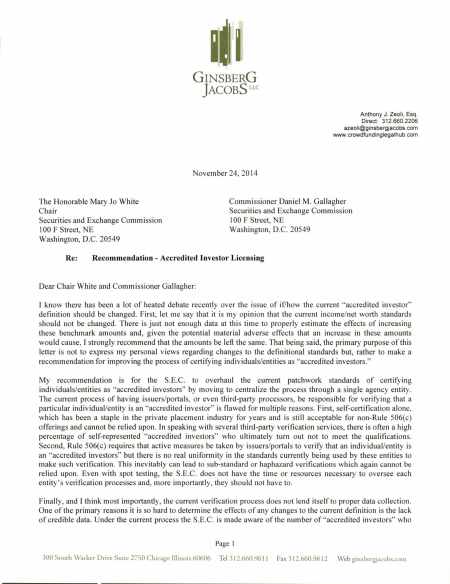 As I have addressed in several of my prior posts, there is an ongoing debate as to whether the S.E.C. should modify the current “accredited investor” standards and, if so, how should they be changed. Regardless of how you may weigh in on the issue, it is hard to deny the fact that there is just not enough useable data regarding private placements (or the types of persons/entities that invest in them) to make an educated assessment as to the potential effects of any changes to these standards. I believe that, unless changes are made to the current certification process, credible data will never be available.
As I have addressed in several of my prior posts, there is an ongoing debate as to whether the S.E.C. should modify the current “accredited investor” standards and, if so, how should they be changed. Regardless of how you may weigh in on the issue, it is hard to deny the fact that there is just not enough useable data regarding private placements (or the types of persons/entities that invest in them) to make an educated assessment as to the potential effects of any changes to these standards. I believe that, unless changes are made to the current certification process, credible data will never be available.
You may be wondering, “How can there not be enough data? Private placements have been around for decades.” That is true but the current standards for certifying individuals/entities as “accredited investors,” and reporting on private placements, simply do NOT lend themselves to collecting the requisite data. Accordingly I contend that, in order to obtain credible data regarding private placements and private placement investors, the entire certification process should be revised. More simply, I am recommending to the S.E.C. that the certification of persons/entities as an “accredited investor” be centralized and each such person/entity be given a unique investor license number. Centralizing the verification processes will give the S.E.C. access to a wealth of information that it is currently unobtainable under the existing standards. Further, it will do so while actually decreasing the time and expense expended by issuers, investors and portals. Sound too good to be true? It’s actually very simple.
number. Centralizing the verification processes will give the S.E.C. access to a wealth of information that it is currently unobtainable under the existing standards. Further, it will do so while actually decreasing the time and expense expended by issuers, investors and portals. Sound too good to be true? It’s actually very simple.
While I outline the process in detail in my letter to the S.E.C. (below), let me walk through a simplified example. Let’s say you wanted to compile data about the number and types of licensed drivers that ride a particular highway during a particular period. In employing a system similar to the current “accredited investor” verification process, you could place a representative at each highway entrance/exit to simply ask each driver if they are licensed. Not only would this process be time/capital consuming and prone to error (e.g. one representative may not be as meticulous as another), but the resulting information would be limited only to the number of licensed drivers who were on the highway during that period and the number of licensed drivers who got on/off at particular location. Not very helpful if you are looking for demographic or other more detailed information regarding the drivers.
Now assume that, instead of simply asking each driver if they were licensed, the representatives simply asked each driver to provide their respective driver’s license number. By doing so, not only would the representatives get the same information as in the previous example, but they would also have access to all of the underlying demographic information of the subject drivers (e.g. name, age, sex, residence, etc.). As a result, with little to no additional effort on the part of the representatives or the drivers, the representatives would have access to a ton of additional information such as, how many male thirty-somethings from Chicago got off the main street exit during the subject period. This is clearly an advantage over the first approach as any attempt to try to  get this kind of information using that approach would be extremely time-consuming and costly for everyone involved (if even possible). Moreover, the second process lends itself to complete automation (e.g. a driver simply imputing their number into a data collection device) further reducing the time/cost required to collect the information.
get this kind of information using that approach would be extremely time-consuming and costly for everyone involved (if even possible). Moreover, the second process lends itself to complete automation (e.g. a driver simply imputing their number into a data collection device) further reducing the time/cost required to collect the information.
While somewhat simplified, the takeaway from the above example is that there is a lot of information that can be obtained using a “licensing” model can that would be too burdensome (if not impossible) to obtain using the current “accredited investor” verification process. There are several other benefits to this approach as well including: “More Reliable Certification, “Increased Privacy Protection,” “Ease of Verification Of New Standards,” and “Continued Certification” (each as outlined, in detail, in my letter)
Will the S.E.C. act on this recommendation? Who knows. Some say that this type of approach would be too expensive for the S.E.C. to implement. I, on the other hand, see no reason why it could not be added on the existing E.D.G.A.R. data collection system in a very cost-effective manner. Either way, what is clear is that something needs to change in order for us to get any type of useable detailed data regarding private placements and private placement investors.
For those that would like to read my letter to the S.E.C. please click below and feel free to leave me any comments as they are always welcome.

